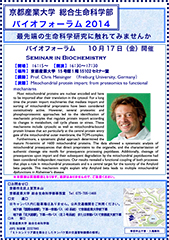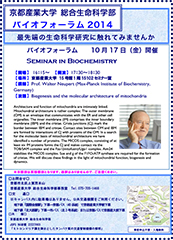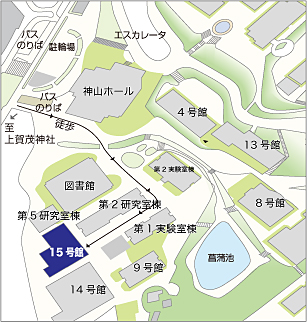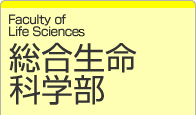総合生命科学部 バイオフォーラム2014 開催(2014.10.17)
最先端の生命科学研究に触れてみませんか
Mitochondrial protein import: from proteomics to functional mechanisms
| 日時 | 2014年10月17日(金) 【開場】16:15〜 【開演】16:30〜17:30 |
|---|---|
| 場所 | 京都産業大学 15号館1階15102セミナー室 |
| 交通 | ※キャンパス内に駐車場はありません。公共交通機関をご利用ください。 交通アクセス |
| 備考 | 事前申込不要・入場無料・一般の方の参加歓迎 |
| 共催 | 京都産業大学 総合生命科学部 JSPS 科研費 22227003「ミトコンドリア膜を舞台としたタンパク質の交通管制機構の解明」 |
講師
Prof. Chris Meisinger (Freiburg University, Germany)
Most mitochondrial proteins are nuclear encoded and have to be imported after their translation in the cytosol. For a long time the protein import machineries that mediate import and sorting of mitochondrial preproteins have been considered constitutively active. However, several proteomic and phosphoproteomic approaches led to the identification of mechanistic principles that regulate protein import according to changes in metabolism, cell cycle phases or stress. These mechanisms include cytosolic as well as mitochondria-bound protein kinases that act particularly at the central protein entry gate of the mitochondrial outer membrane, the TOM-complex.
Furthermore, a systematic global approach determined the mature N-termini of >600 mitochondrial proteins. The data allowed a systematic analysis of mitochondrial presequences that direct preproteins to the organelle, and the characterization of authentic cleavage site motifs for presequence processing peptidases. Additionally, cleavage of presequences upon import and their subsequent degradation by the mitochondrial peptidasome had been considered independent reactions. Our results revealed a functional coupling of both processes that plays a role in mitochondrial proteostasis and is a central target for the toxicity of the Amyloid beta peptide. This mechanism might explain why Amyloid beta leads to multiple mitochondrial dysfunctions in Alzheimer’s disease.
※本講演は英語講演となります。通訳はありませんので、ご注意ください。
Biogenesis and the molecular architecture of mitochondria
Prof. Walter Neupert氏の講演については演者の都合により、中止となりました。
講師
Prof. Walter Neupert (Max-Planck Institute of Biochemistry,Germany)
Architecture and function of mitochondria are intimately linked. Mitochondrial architecture is rather complex: The outer membrane (OM) is an envelope that communicates with the ER and other cell organelles. The inner membrane (IM) comprises the inner boundary membrane (IBM) and the cristae. Crista junctions (CJ) mark the border between IBM and cristae. Contact sites between OM and IBM are formed by interactions of CJ with proteins of the OM. In a search for the molecular basis of mitochondrial architecture we have identified a number of proteins. The MICOS complex, consisting of at least six IM proteins forms the CJ and makes contact via the TOB/SAM complex and the Fzo1(mitofusin)/Ugo1 complex. Aim24 stabilizes the MICOS complex. Sue and g of the F1FO-ATP synthase are required for the formation of cristae. We will discuss these findings in the light of mitochondrial function, biogenesis and dynamics.
※本講演は英語講演となります。通訳はありませんので、ご注意ください。




